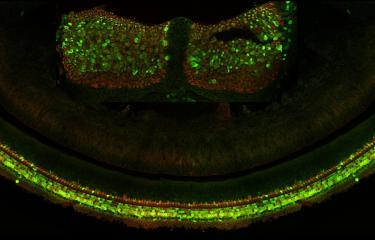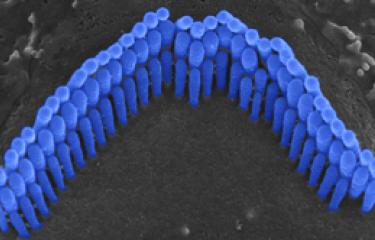Scientists at the Institut Pasteur, Inserm, the Collège de France and Pierre & Marie Curie University, working closely with scientists at the University of Auvergne, have recently discovered the function of pejvakin, a molecule that plays a vital role in the hearing system. The absence of this molecule appears to be responsible for noise-induced hearing loss, one of the most common causes of deafness. The scientists' discovery, which was published on November 5 in the journal Cell, offers new prospects for the treatment of this condition.

Before sound exposure After sound exposure
Sound exposure induces a proliferation of peroxisomes (in green) in the auditory sensory cells of mice harboring pejvakin (Pjvk+/+, center) and causes their degeneration in mice lacking pejvakin (Pjvk-/-, right). © Institut Pasteur
In 2006, the team led by Christine Petit in the Institut Pasteur's Genetics & Physiology of Hearing Unit, especially Sedigheh Delmaghani, working in cooperation with Paul Avan's team at the University of Auvergne's Laboratory of Sensory Biophysics, identified a new gene that was responsible for early-onset sensorineural hearing loss. This gene codes for a protein which was given the name "pejvakin" (which means "echo" in Persan). Audiometric tests performed on individuals with mutations in this gene subsequently revealed an unusually high level of diversity in hearing impairments, in terms of both severity and characteristics. This latest study, carried out by scientists from the Institut Pasteur, Inserm, the Collège de France, Pierre & Marie Curie University and the University of Auvergne, aimed to clarify the reasons for this heterogeneity.
The scientists, particularly Sedigheh Delmaghani, studied young mice whose pejvakin gene had been inactivated. Their observations revealed an astonishing variation in hearing impairments from one mouse to the next, ranging from mild to profound hearing loss. Young mice are highly vocal for the first three weeks after they are born, particularly when feeding. The more mice there are in the cage, the noisier their acoustic environment. The scientists observed that as the number of mice in the cage increased, so did their hearing threshold – the minimum sound level at which they are able to hear sounds. Using direct, controlled acoustic stimulation, the scientists were able to prove that the auditory system of mice lacking in pejvakin is affected by their acoustic environment.
The scientists then set about investigating the physiological causes of this phenomenon. They observed that in mice without pejvakin, the auditory sensory cells are damaged as soon as they are exposed to even seemingly harmless sounds – the equivalent of a minute spent in a nightclub for humans. These cells need two weeks of silence to become functional again. With prolonged or repeated exposure, the cells eventually die. The scientists also identified the noise-sensitive element in the cell as being the peroxisome, a small organelle involved in detoxification. "To put it simply, we discovered that a genetic disorder could be responsible for noise-induced hearing loss triggered by even very low noise levels," explained Christine Petit.
The auditory sensory cells in people with impaired pejvakin were observed to be extremely vulnerable to noise. When a standard hearing test was performed on these hearing-impaired individuals, the responses of their auditory sensory cells and neurons, although normal to begin with, gradually worsened as the test went on as a result of the sounds used.
Noise-induced hearing loss is becoming increasingly prevalent. Urban crowding means that large cities are getting noisier, particularly in developing countries. WHO predicts that by 2030, one billion people will be at risk of noise-induced hearing loss. "Some of us have less effective natural defenses against the impact of overexposure to sound than others," explained Profs. Avan and Petit. "Five million people in France end up suffering from hearing loss, which has a negative impact on their social life. Hearing aids are one solution, but they work by exposing the wearer to amplified sounds. However, we don't yet know what percentage of the population is either lacking in pejvakin or has a less effective form of the protein. Our findings indicate that in these people, hearing aids are most probably not only ineffective but also harmful."
The scientists will now look into possible techniques to restore the function of pejvakin, particularly using gene therapy, which has already proved successful in conserving hearing in mice lacking in pejvakin, even when they are overexposed to noise.
This study received funding from the Louis-Jeantet Foundation, the Bettencourt Schueller Foundation, Humanis, AG2R La Mondiale, the BNP Paribas Foundation and Agir pour l’Audition Foundation.
Source
Hypervulnerability to sound-exposure through impaired adaptive proliferation of peroxisomes, Cell, November 5, 2015.
Sedigheh Delmaghani (1,2,3), Jean Defourny (1,2,3), Asadollah Aghaie (2,3,4), Maryline Beurg (5), Didier Dulon (5), Nicolas Thelen (6), Isabelle Perfettini (1,2,3), Tibor Zelles (7,8), Mate Aller (7), Anaïs Meyer (1,2,3), Alice Emptoz,(1,2,3), Fabrice Giraudet (9,10,11), Michel Leibovici (1,2,3), Sylvie Dartevelle (12), Guillaume Soubigou (13), Marc Thiry (6), E. Sylvester Vizi (7), Saaid Safieddine (1,2,3), Jean-Pierre Hardelin (1,2,3), Paul Avan (9,10,11,15) and Christine Petit (1,2,3,4,14,15,*)
(1) Unité de Génétique et Physiologie de l’Audition, Institut Pasteur, 75015 Paris, France
(2) UMRS 1120, Institut National de la Santé et de la Recherche Médicale (INSERM), 75015 Paris, France
(3) Sorbonne Universités, UPMC Université Paris 06, Complexité du Vivant, 75005 Paris, France
(4) Syndrome de Usher et Autres Atteintes Rétino-Cochléaires, Institut de la Vision, 75012 Paris, France
(5) Equipe Neurophysiologie de la Synapse Auditive, Université de Bordeaux, Neurosciences Institute, CHU Pellegrin, 33076 Bordeaux, France
(6) Unit of Cell and Tissue Biology, GIGA-Neurosciences, University of Liege, CHU Sart-Tilman, B36, 4000 Liege, Belgium
(7) Institute of Experimental Medicine, Hungarian Academy of Sciences, H-1083 Budapest, Hungary
(8) Department of Pharmacology and Pharmacotherapy, Semmelweis University, H-1089 Budapest, Hungary
(9) Laboratoire de Biophysique Sensorielle, Université d’Auvergne, 63000 Clermont-Ferrand, France
(10) UMR 1107, Institut National de la Santé et de la Recherche Médicale (INSERM), 63000 Clermont-Ferrand, France
(11) Centre Jean Perrin, 63000 Clermont-Ferrand, France
(12) Plateforme d’Ingénierie des Anticorps, Institut Pasteur, 75015 Paris, France
(13) Plateforme Transcriptome et épigénome, Institut Pasteur, 75015 Paris, France
(14) Collège de France, 75005 Paris, France
(15) Senior co-author
(*) Corresponding author







